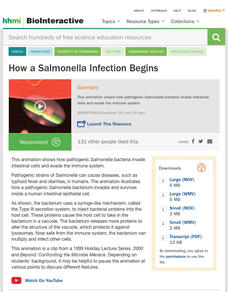Clarendon Learning
Cells for Kids | Learn about cell structure and function in this engaging and fun intro to cells
Cells for kids is an engaging and fun look at the function and structure of cells. In this video we compare the differences between animal and human cells vs plant cells. We first identify the parts of a cell including the Nucleus,...
Curated Video
GCSE Biology - What is Microscopy? #5
In this video, we cover: - The different parts of a microscope - What the terms image, object, magnification and resolution mean Exam board specific info: AQA - Suitable for everyone IGCSE Edexcel - Suitable for everyone Edexcel -...
Mazz Media
Blood Vessels
This live-action video program is about blood vessels. The program is designed to reinforce and support a student's comprehension and retention of the term through use of video footage, photographs, diagrams and colorful, animated...
FuseSchool
Sexual Reproduction in Plants
In this video, we will be looking at sexual reproduction in plants. Did you know that there are an estimated 390,900 plant species known to science? This diversity of plant species is, in part, due to sexual reproduction. In plants,...
Curated Video
The Anatomy and Function of the Eye
This video is the first of two lecture presentations on the structure and function of the eye. The presenter gives an overview of what the eye is and how it functions as a sensory receptor for detecting changes in light intensity. The...
Curated Video
The Structure and Function of the Human Eye
This video is a lecture presentation about the structure and function of the human eye. The speaker explains the different parts of the eye, their functions, and how they work together to allow us to see. They discuss the sclera, cornea,...
Curated Video
Sexual Reproduction in Plants | Plants | Biology | FuseSchool
Sexual Reproduction in Plants | Plants | Biology | FuseSchool In this video, we will be looking at sexual reproduction in plants. Did you know that there are an estimated 390,900 plant species known to science? This diversity of plant...
World Science Festival
Nanotechnology’s Promise: A Big Risk in a Small Package?
Microscopic, manmade nanoparticles have found their way into almost every part of our daily lives from clothing, to skin care, our cell phones, and even the soil. But how safe are we from ill effects from extensive exposure? And what...
Professor Dave Explains
Widefield and Confocal Fluorescence Microscopy
We just learned about electron microscopy, so what was the next major innovation in microscopy in the 20th century? That would be fluorescence microscopy, of both the widefield and confocal varieties. How does this work? What is...
Bozeman Science
A Tour of the Cell
Adult humans are made of around 40 trillion cells that can't be seen these without some really powerful microscopes! Learners tour both prokaryotic and eukaryotic cells, learning how their structures are similar and different, and then...
Teacher's Pet
Parts of the Eukaryotic Cell
Lipids found in your body include oils, fats, and hormones. The video discusses lipids and their importance to your body, wax, and vitamins. Then, it identifies and explains the job of each part of eukaryotic cells.
Ricochet Science
Prokaryotic Vs. Eukaryotic Cells
Viewers learn about prokaryotic and eukaryotic cells in the third installment of a five-part video series. The video covers the similarities and differences between these two types of cells, including a brief etymological aside on how...
Teacher's Pet
Cell History
While Robert Hooke discovered the cell in 1665, the first cell theory didn't come about until the 1830s. The video explains the discovery of the cell and the scientists involved. It continues to the parts of cell theory and the...
Curated OER
Tour of the Cell 1
Each of these slides deals with an individual organelle and displays a diagram along with labels of the structures. The most useful components of this slideshow are the summaries of functions and descriptions of how the organelles are...
FuseSchool
Intro to Cells: Animal, Plant, Nerve and Red Blood Cells
Throw your dendrites in the air and wave 'em like you just don't care! An excellent video in the Fuse School playlist explains the parts and functions of cells. It describes their structures, functions, and specialties.
Howard Hughes Medical Institute
Intracellular Infection by Salmonella
Bacteria are pesky little organisms that can often easily infect us. But how? Salmonella bacteria literally gets under our skin. Viewers see how the dangerous bacteria protects itself from defense mechanisms inside the cell.
Curated OER
Tic Tac Plant Parts
This plant biology PowerPoint introduces plant parts and their functions. This PowerPoint allows students to identify each plant part on a diagram, along with its' function. The slides contain a clear explanation of how each plant part...
Teacher's Pet
Leaf Structure Lab
Two guard cells protect every stoma on a leaf. The video explains the structures of leaves, including stomatas. It details how to identify the parts under a microscope.
Curated OER
Mutations
The basics of mutation types and some potential effects of those are described and diagrammed here. Each detail is very clear and includes the labels and translation change exhibited. A great slideshow to expand on DNA replication issues.
Bozeman Science
Bacteria
Is the other side of bacteria called fronteria? Introduce bacteria with a video that covers where it fits on the tree of life, the structure and functions of each part, the shapes and metabolism for various types of bacteria,...
Crash Course
Tissues – Types of Connective Tissues (Part 4)
Did you know your blood and bones are examples of connective tissue? This is video number five in a series of 47 and further explores connective tissues. Pupils learn about other types of connective tissues, what these look like, where...
American Chemical Society
What's in your Smartphone?
Your cell phone contains many elements you may not have even heard of! Explore the science of the smartphone with a lesson from the Reactions playlist. The instructor explains the location and purpose of the many different elements that...
TED-Ed
The Surprising Reason Our Muscles Get Tired
Does pain really indicate gain when it comes to muscle aches? A short, animated video details the science behind the pain associated with muscle fatigue.
Howard Hughes Medical Institute
The Proteasome
How do cells get rid of worn out proteins? Using a short video clip, viewers learn about the role of ubiquitin in flagging worn-out proteins and see how the proteasome degrades flagged proteins.




















